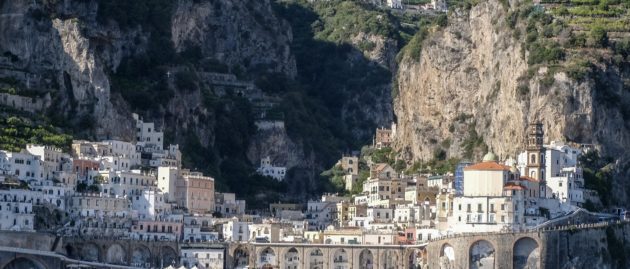Sorrento is one of the favorite destinations in Italy, you will pass by the streets along with the scents of nearby lemon groves, to discover its Greek and Roman origins, from Villa Comunale to Piazza Tasso, passing by Sedil Dominova and the Duomo. On the way to Positano and Amalfi you will have the opportunity to admire the famous coastline immersed in sea, history and nature. Lush gardens and bougainvillea fill the terrace of charmig pastel-coloured houses of Positano. Amalfi is a perennial favourite with visitors for its scenic beauty, sea and original architecture like the famous Duomo of Sant’Andrea.
Where does Positano name come from?
Positano is perhaps the best known town on the Amalfi coast. It is a very famous tourist destination with stone beaches and small streets full of shops, bars and typical craftsmen. The majolica dome of the Church of Santa Maria Assunta is an icon of Byzantine art dedicated to the 13th century Virgin Mary. The charm of the sea joins the local tradition which, together with the landscape attractions, attracts thousands of visitors.
According to legend, on the night of August 14th a band of Saracen pirates landed on the Spiaggia Grande di Positano. They set the town on fire with a series of raids and violence and stole the sacred image of the painting of the black Madonna, a 12th century Byzantine icon, when they had almost set sail from the pier, a furious storm broke out involving wind and sea thus the voice of the Virgin was heard asking to be left on the ground: “Pose, Pose!”. And from here the name was born: Positano. The sailors obeyed and, converting to the Christian faith, brought the sailing ship to the inlet where the Madonna was disembarked. In the place where the sacred image was found, a church was built in honor of the Virgin and the town was built around it.
Over the centuries this myth has perpetrated in popular memory, with religious celebrations and spectacular fireworks. Hundreds of boats and yachts arrived every year in the small bay from all the towns of the Amalfi Coast and the Sorrento Coast, from Castellammare to Sorrento, from Salerno to Amalfi, to admire them from the sea as they rise into the sky at midnight, then folding in the reflections of the waves.
Groups of people are still created on each terrace and balcony, admiring the spectacle of lights, colors and sounds of the 15 August festival, which mixes sacred and secular rites, ancient beliefs, sounds and popular traditions. A spectacular historical re-enactment: about four hundred actors and figures with characteristic costumes staged the landing of the Saracens and the miraculous intervention of the Madonna, then the fake fire of the country and the kidnapping of the virgins. Finally, we went to the beach until late to eat bread and melon, in the most classic Positano tradition.
The maritime tradition of Amalfi
Amalfi is certainly known for its majestic Duomo, consecrated to Sant’Andrea. The temple, built in the 9th century, was renovated several times, until the final renovation following the 1861 earthquake. The cloister known as Paradise, also erected in 1266 by archbishop Filippo Austroungarico in Arabic style, is also known. Many peoples have crossed these territories and have left traditions and customs that have remained in modern history, but what remains most impressed is the maritime tradition of the Amalfi people.
Amalfi throughout the Middle Ages had a large and powerful fleet, both military and mercantile. The military was repeatedly victorious especially in the battles fought against the Arabs in defense of Christianity, in 849 the ships of Amalfi helped save Rome from the attack of a powerful Muslim fleet. For the construction of warships Amalfi had a masonry arsenal of which today two lanes divided by ten pillars remain and it is the only surviving example of medieval arsenal in southern Italy. Merchant ships were built on the beaches, which were indicated by the Byzantine term of unloading. The medieval Amalfi scarium is today under the sea in front of the city, where piers and moorings of the medieval age have recently been discovered. The port facilities were submerged following a submarine landslide caused by a storm in Libeccio, between 24 and 25 November 1343. This phenomenon gave the coup de grace to merchant and maritime situation already in decline
Today the remains of the maritime history of Amalfi, are the arsenal, the maritime code called Tabula de Amalpha and the tradition of the invention of the compass remain. This code is kept in a seventeenth-century hard copy at the Civic Museum; it was elaborated between the XI and XIV centuries and its chapters contain surprising news about the advanced and advanced Amalfi seafaring society.
Sorrento and his lemons
Who says lemons says Sorrento! this fruit is grown in traditional citrus groves scattered throughout the hills of the Sorrento Peninsula and is beautifully set in the fascinating and evocative territory that hosts it. Its tipical yellow flesh and its acidic juice make it unmistakable and famous all over the world for its incomparable perfume.
Already loved at the time of the ancient Romans, he was also the protagonist of many paintings of the period, also found in the nearby Pompeii and Herculaneum ruines.
Always used to season the typical dishes of Mediterranean cuisine, from the aperitif to the dessert, but above all for the preparation of limoncello. This digestive liqueur boasts its birth in the early 1900s, but nobody knows if the origin is from Capri, Sorrento or Amalfi. it is obtained by leaving the lemon peel to soak in alcohol and then adding the syrup of water and sugar and left to mature for weeks before reaching its classic yellow color. can not miss on the tables at the end of each meal. you can no longer do without it!
Categories: Tour campania



